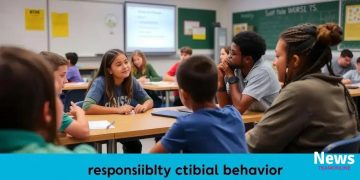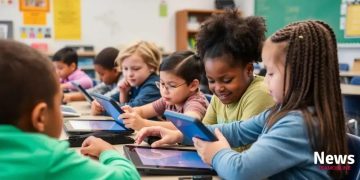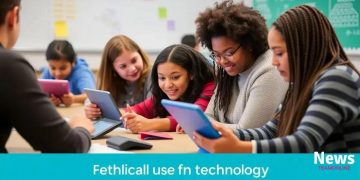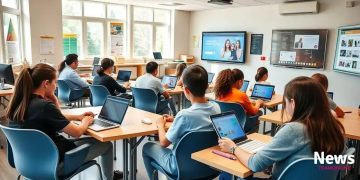Technology-integrated curriculum: Transforming education today
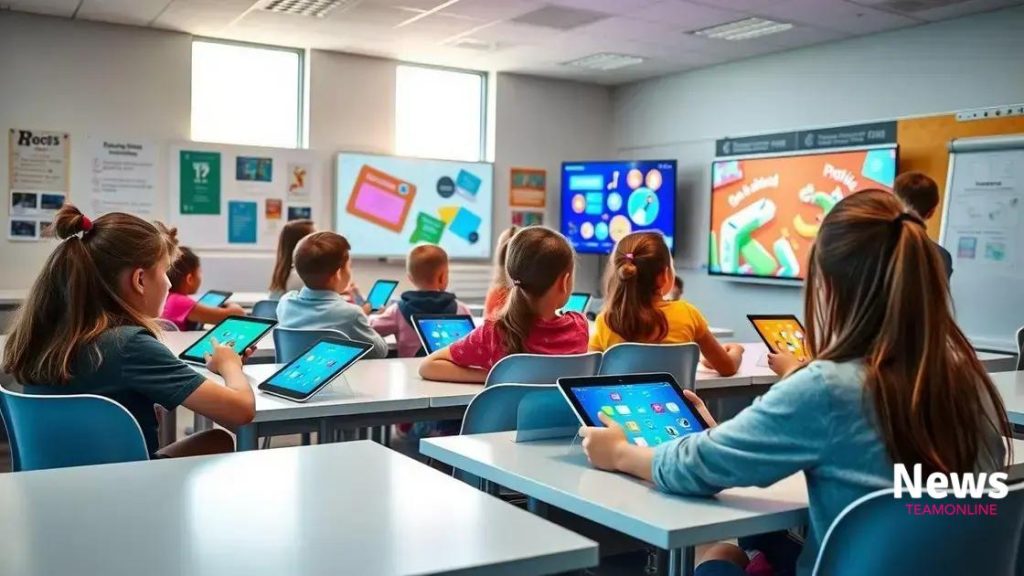
A technology-integrated curriculum enhances education by incorporating digital tools and resources, fostering personalized learning experiences, and promoting collaboration among students while addressing challenges like budget constraints and resistance to change.
Have you ever wondered how a technology-integrated curriculum can reshape the learning experience? By weaving technology into everyday lessons, educators can spark excitement and engagement among students, making learning more accessible and interactive. Let’s dive into how this approach is transforming classrooms.
Understanding technology-integrated curriculum
Understanding a technology-integrated curriculum is essential for modern education. It involves blending technology into everyday learning to enhance student engagement and effectiveness. By leveraging various tech tools, educators can create richer educational experiences.
Key Components of a Technology-Integrated Curriculum
Several elements come together to form an effective curriculum. Teachers must consider how to incorporate technology not just as an add-on, but as a fundamental part of lessons. This approach requires careful planning to align with educational goals.
- Interactive Learning Tools
- Digital Collaboration Platforms
- Access to Online Resources
- Assessment and Feedback Technologies
The integration of these components helps create a dynamic environment. Students learn how to research, create, and present information in ways that are relevant today. This prepares them for a world where tech skills are essential.
Benefits of Technology Integration
Integrating technology offers several benefits. It fosters collaboration among students, encourages critical thinking, and can even cater to different learning styles. For instance, visual learners may benefit from videos and infographics, while auditory learners might excel with podcasts and discussions. This flexibility allows educators to reach every student effectively.
Moreover, technology can simplify communication. Educators can provide instant feedback and share resources quickly, making learning more fluid and responsive. When students feel supported, they are more likely to engage with the material and succeed academically.
Overall, a technology-integrated curriculum not only enriches the learning experience but also prepares students for future challenges. By incorporating technology, educators create an interactive and supportive educational environment that enhances learning.
Benefits for teachers and students
Integrating technology into education brings numerous benefits for both teachers and students. This approach not only streamlines classroom management but also enhances the overall learning experience.
Advantages for Teachers
For teachers, a technology-integrated curriculum simplifies many tasks. It allows teachers to access a wealth of resources online, from lesson plans to multimedia content that can make lessons more engaging. Additionally, technology enables efficient grading and assessment methods.
- Improved organization of materials
- Enhanced communication tools with students and parents
- Access to a variety of teaching resources
- Time-saving automation for administrative tasks
With these advantages, teachers can focus more on helping students understand the material instead of managing paperwork and logistics.
Advantages for Students
Students gain equally from a technology-integrated curriculum. They enjoy interactive learning experiences that cater to their varied learning styles. For instance, visual learners can thrive with videos, while auditory learners can benefit from podcasts and discussions.
Furthermore, technology promotes collaboration among peers. Students can work together on projects using platforms that support sharing and co-editing. This cooperation enhances their learning and builds valuable teamwork skills.
Additionally, students have access to a broader range of information and resources. This helps in developing research skills and enhancing critical thinking. By learning how to evaluate sources, they become more informed individuals.
Overall, a technology-integrated curriculum benefits both teachers and students, creating a more dynamic and effective learning environment.
Practical strategies for implementation

Implementing a technology-integrated curriculum requires practical strategies that ensure smooth transitions and effective use of resources. Schools can adopt various methods to blend technology into teaching effectively.
Choosing the Right Tools
First, it is crucial to select the appropriate technology tools that align with learning objectives. Consider tools like educational software, online resources, and interactive platforms. The focus should be on those that encourage student engagement and facilitate learning.
- Research educational apps that fit your curriculum.
- Test different platforms to find the best ones.
- Choose tools that offer collaborative features for students.
- Make sure resources are accessible for all students.
By carefully selecting the right tools, educators can enhance the classroom experience and foster a more engaging environment.
Training and Support for Teachers
Teacher training is essential when adopting any new technology in the classroom. Providing ongoing support ensures that educators feel confident using these tools. Professional development workshops can help teachers learn how to incorporate technology into their lessons seamlessly.
Additionally, establishing a support network within the school can help teachers share best practices and troubleshoot challenges together. This camaraderie increases comfort and encourages innovative use of technology.
Moreover, having a technology champion in the school can provide the necessary guidance and encouragement. This person can offer insights and help integrate the technology into daily lessons more effectively.
Fostering a Culture of Innovation
Encouraging a culture of innovation within the school community can make it easier to adopt technology. Encourage teachers and students to experiment with different tools and approaches. This trial-and-error process is valuable for discovering what works best for your unique classroom setting.
It’s important to gather feedback regularly. This way, educators can refine their methods and ensure the technology meets their needs. Celebrate successes and learn from failures together.
Overall, practical strategies for implementing a technology-integrated curriculum center on careful planning, teacher support, and a culture of experimentation that fosters ongoing learning.
Challenges in adopting new technology
Adopting new technology in education comes with several challenges that schools must address. Understanding these obstacles helps educators and administrators create effective solutions.
Resistance to Change
One major challenge is the resistance to change among both teachers and students. Many educators may feel comfortable with traditional teaching methods. Transitioning to a technology-integrated curriculum can seem daunting. It is essential to provide training and support to ease these fears.
- Addressing misconceptions about technology.
- Providing hands-on training sessions.
- Encouraging open discussions about concerns.
- Highlighting success stories from early adopters.
Creating a supportive environment can help ease the transition and motivate teachers to embrace new tools.
Budget Constraints
Another common hurdle is budget constraints. The cost of purchasing new technology and maintaining it can be significant. Schools must find ways to prioritize funding for technology initiatives. This may involve seeking grants, partnerships, or community support to alleviate financial burdens.
Additionally, strategic planning can help ensure that technology investments align with educational goals. By assessing the specific needs of students and teachers, schools can make informed decisions about what technology is truly necessary.
Technical Issues and Support
Implementing new technology often brings technical challenges as well. This can include software compatibility issues, internet connectivity problems, or hardware malfunctions. Having reliable IT support is crucial for addressing these issues promptly.
Regular maintenance and updates should be part of the technology plan. Schools should ensure they have a dedicated team to manage and troubleshoot technology-related problems.
Overall, recognizing and addressing these challenges is essential for successfully adopting new technology. With the right strategies in place, schools can create a more effective and engaging educational environment.
Future trends in educational technology
The landscape of education is continually evolving, and future trends in educational technology promise to reshape how students learn and teachers teach. Keeping an eye on these trends is essential for educators and institutions that aim to remain at the forefront of effective teaching practices.
Artificial Intelligence and Personalization
One significant trend is the increasing use of artificial intelligence (AI) in education. AI can provide personalized learning experiences tailored to individual student needs. For example, AI-powered tools can analyze a student’s performance and offer targeted resources to help them improve.
- Personalized learning plans based on student data.
- Adaptive testing that adjusts difficulty levels.
- Chatbots for instant assistance and tutoring.
- Insights generated from learning analytics.
These advancements create a more engaging and effective learning environment, promoting better academic outcomes.
Virtual and Augmented Reality
Another exciting development is the use of virtual reality (VR) and augmented reality (AR) in classrooms. These technologies allow students to immerse themselves in interactive environments. For instance, a history class could take virtual field trips to ancient civilizations, enriching the learning experience far beyond traditional methods.
AR can enhance textbooks and presentations by overlaying digital information onto real-world objects, making lessons more tangible and captivating.
Online Collaboration Tools
With the rise of remote learning, online collaboration tools are becoming essential. Platforms that allow students to work together on projects from different locations help foster teamwork skills. These tools enable communication through video conferencing, shared documents, and group discussion boards.
Some popular collaboration tools include Google Workspace, Microsoft Teams, and Zoom. They facilitate seamless interaction and project management, offering students a taste of real-world work environments.
Focus on Digital Citizenship
As technology becomes more integrated into education, teaching digital citizenship is vital. Students must learn how to use technology responsibly and effectively. This includes understanding online privacy, recognizing misinformation, and practicing respectful communication.
Embedding digital citizenship into the curriculum helps prepare students for a world where technology plays a central role in everyday life.
In summary, as we look toward the future, these trends in educational technology highlight the importance of innovation and adaptability in teaching and learning. Harnessing these advancements can create more engaging, personalized, and effective educational experiences.
FAQ – Questions about technology-integrated curriculum in education
What is a technology-integrated curriculum?
A technology-integrated curriculum blends digital tools and resources into everyday lessons, enhancing student engagement and learning outcomes.
How can AI benefit the educational experience?
AI can personalize learning experiences, offering tailored resources and assessments based on individual student performance.
What are the challenges of adopting new technology in schools?
Challenges can include resistance to change from teachers and students, budget constraints, and needing reliable technical support.
Why is teaching digital citizenship important?
Teaching digital citizenship helps students understand how to use technology responsibly, ensuring they navigate online environments safely and respectfully.

